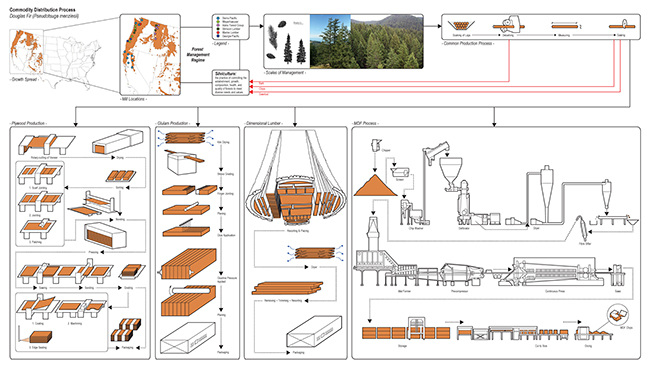carbonurbanism: projective futures
Carbon C is ubiquitous—it is one of the primary elements supporting life on earth, the fourth most abundant element in the universe, and it makes up 18.5% of the human body. Global economies have increasingly relied on carbon-based resources since the industrial revolution (fuel, plastics, paving, building materials, etc.), and its steady increase in release into the atmosphere is one of the major contributing factors to climate change. From the EPA: “Carbon dioxide is naturally present in the atmosphere as part of the Earth\’s carbon cycle (the natural circulation of carbon among the atmosphere, oceans, soil, plants, and animals). Human activities are altering the carbon cycle—both by adding more CO2 to the atmosphere and by influencing the ability of natural sinks, like forests, to remove CO2 from the atmosphere. While CO2 emissions come from a variety of natural sources, human-related emissions are responsible for the increase that has occurred in the atmosphere since the industrial revolution.”
But within discussions on sustainability, energy neutrality, etc., few have probed the relevance of or development of a carbon-based framework for framing and informing individual projects or—more appropriately—the broader projects of urbanism. Our work in this research seminar will do just this:
·what are the implications of a carbon-based future?
·how do we define and measure such a thing?
·how do we imagine and project such futures?
·how might these speculations transform the ways in which our metropolitan networks, infrastructures, and ways of life are conceived and realized?
The work in the seminar will be very much research-oriented, student-project-based, and projective. Initial seminar sessions will focus on broad-based approaches to urbanism, ecology, landscape, and infrastructure, while a later session on exhibition making will be held at pink comma gallery in Boston. Visitors will include Kiel Moe and Jane Hutton (energy), Denise Hoffman (carbon sinks) and Chris Grimley and Mark Pasnik (curation). A joint session on energy and design is planned with Phillipe Rahm and Silvia Benedito. Lectures will be supplemented by workshops and tutorials on dynamic modeling software led by Robert Pietrusko and Bradley Cantrell. A number of seminar sessions will be devoted to individual review and feedback on research proposals.
Student-generated research projects will be based around topical interests; they may be focused on carbon in the abstract, or on in-depth studies of the carbon- and infrastructure-based systems of representative North American auto-dependent cities, or on the representation and digital modeling of those systems and dynamics. The research work will be design-focused and intensive. Project presentations can be in the format of a paper and oral presentation; or a set of visualization drawings and animations for exhibition. The presentations may take the form of a full-day colloquium, while some of the work may also be included in exhibitions and events at Zaha Hadid’s Eli and Edythe Broad Art Museum in Michigan and pink comma gallery in Boston.
Students from MDes, architecture, landscape architecture, and UPUD are all encouraged to participate. Some software training workshops and teaching assistance will be provided, but it is not intended that all student projects be software-based.
